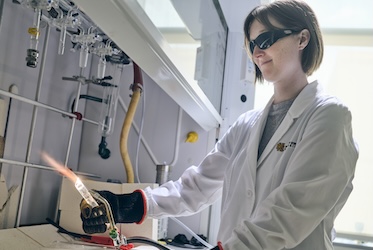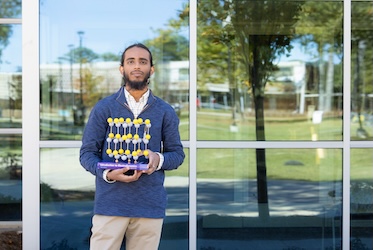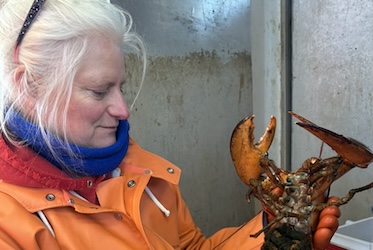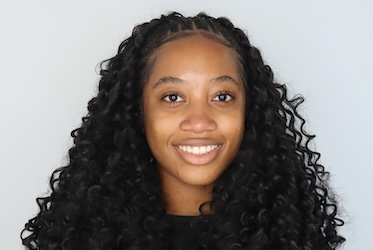

KENNESAW, Ga. | Oct 22, 2020
It turns out humans can learn something from animals when it comes to engineering.
A laboratory in Kennesaw State University’s College of Science and Mathematics focuses on how animals negotiate complex water flows to help humans in their design of vessels such as autonomous underwater vehicles and propulsive systems that can navigate unsteady flow environments, like rainfalls or rivers.
“We’re interested not only in how nature solves problems through the process of natural selection, but in how we might learn from that to improve engineering designs,” said professor of biology Christopher Sanford. “By looking at how fish swim and how natural selection might have improved swimming efficiency and movement, we can help rapidly advance how robots move underwater in challenging environments.”
One example is the ghost knifefish, a popular domestic fish, which Sanford and his team of researchers in KSU’s department of Ecology, Evolutionary and Organismal Biology are studying to learn how it easily negotiates complex flows despite its thin stature.

The researchers discovered that knifefish do three things that help them feed and navigate in fast flowing waters. First, their suction feeding behavior is so powerful it can vaporize water. Second, knifefish use multiple fins in different ways to navigate complex flows. Finally, knifefish are able to efficiently navigate narrow passages with ease and without creating adverse drag that would hold them back.
“We did some experiments showing that these fish can move through turbulent waters,” researcher Victor Ortega-Jimenez said. “In a small water tunnel, we mimic different flow environments that demonstrate knifefish are very good at moving efficiently in such complex flows.”

Ortega-Jimenez joined the lab in March 2019 after several years studying how animal fliers deal with adverse flow environments, such as dust devils, rain or waterfalls. Recently, he published a research on how small insects and hummingbirds are limited by size in passing through lab-created cascades. He suggested from this study that swifts can protect their chicks from small bloodsucking insects by nesting behind waterfalls.
Ortega-Jimenez said he joined the lab in part to expand his knowledge, adding fish that swim through complex flows to his existing expertise in birds that fly through wet and turbulent environments. But he also wanted to conduct experiments in Sanford’s lab because it has equipment that can investigate three-dimensional flow, allowing researchers to better understand movement through those flows.
“Not all labs have this technology,” Ortega-Jimenez said. “I came here because of all the possibilities of experimentation, and because of my interest in complex fluids. I’ve been working with insects skimming the water surface, and now I'm exploring what happens with fish swimming, taking into account how these movements are affected by this complexity of the water flow.”
Sanford credits Ortega-Jimenez, who has a website and YouTube channel dedicated to his research, with the importance of being able to communicate to the general public in a way that they can understand how important scientific discovery is.
“The one area where scientists must do a better job is communicating to a broader audience,” Sanford said. “There’s no question that we have a long way to go in that regard, and Victor’s video and photo expertise can certainly help bridge that gap.”
As an educator, Ortega-Jimenez said it’s important to meet students where they are, so making the material relatable through video fulfills that goal.
“Video material is a great way to explain science while engaging students, as well as reaching a broader audience,” Ortega-Jimenez said. “For almost all of my research papers, I have created short videos summarizing my findings that I upload to my webpage and my YouTube channel.”
Sanford said humans can use their understanding of movement and shape in animals to help accelerate the development of more efficient machines or robots that can navigate, for example, shipwreck sites in salvage missions or drones that can conduct search-and-rescue missions in storms. In fact, one area of research elaborates specifically on the ghost knifefish’s suction aspects, though Sanford said the possibilities are endless when it comes to applying animal movements to human-engineered robots.
“Successful examples are everywhere and as technology, miniaturization, and artificial intelligence advances it will become integral to improving the quality of life for everyone,” Sanford said. Once you start looking at natural systems, there’s so many cool aspects to it, be they fish ascending 300-foot waterfalls or birds flying through waterfalls in order to get to another location. How do organisms navigate through treacherous conditions? I think it’s cool because there are so many neat examples out there of extreme designs.”
– Dave Shelles
Photos by David Caselli

Kennesaw State assistant professor, lab open doors to hands-on innovation in chemistry

Research conducted by Kennesaw State student could lead to faster, more efficient electronics

Well-traveled lobster the latest point of intrigue in Kennesaw State dean's research

Kennesaw State Honors student builds pathways to learning for children in Cameroon
A leader in innovative teaching and learning, Kennesaw State University offers undergraduate, graduate, and doctoral degrees to its more than 47,000 students. Kennesaw State is a member of the University System of Georgia with 11 academic colleges. The university’s vibrant campus culture, diverse population, strong global ties, and entrepreneurial spirit draw students from throughout the country and the world. Kennesaw State is a Carnegie-designated doctoral research institution (R2), placing it among an elite group of only 8 percent of U.S. colleges and universities with an R1 or R2 status. For more information, visit kennesaw.edu.